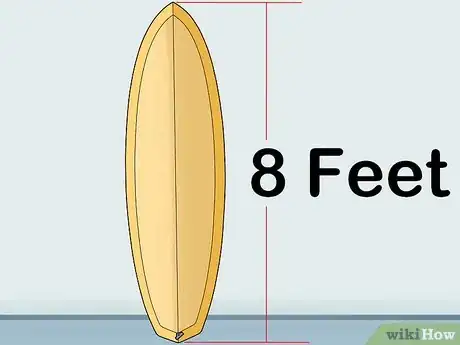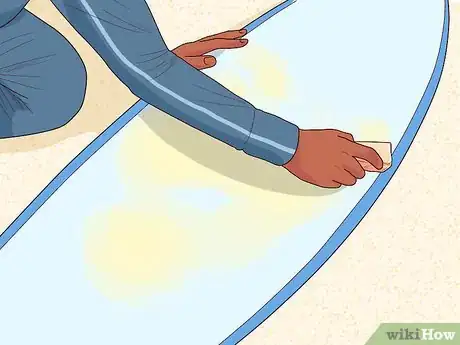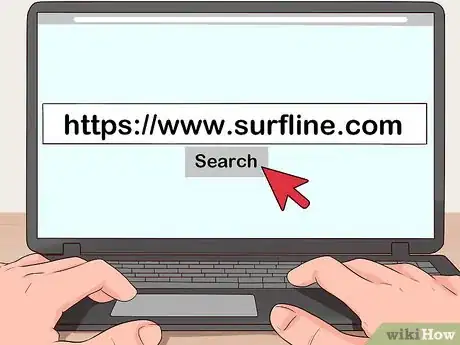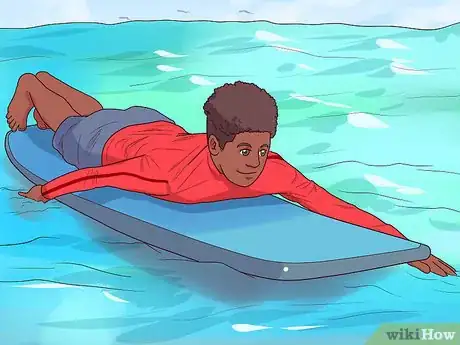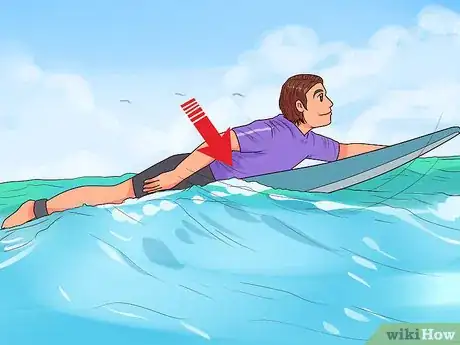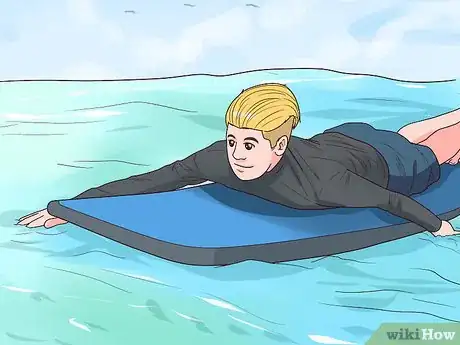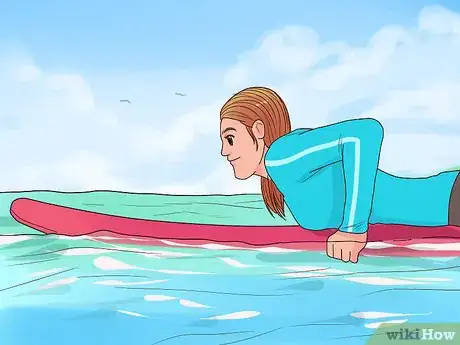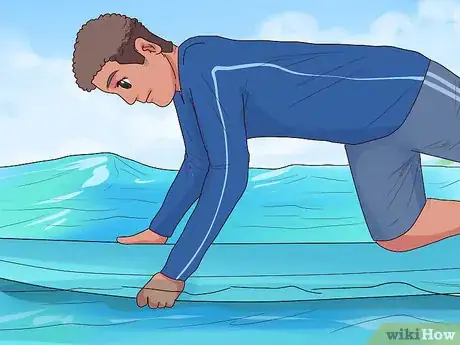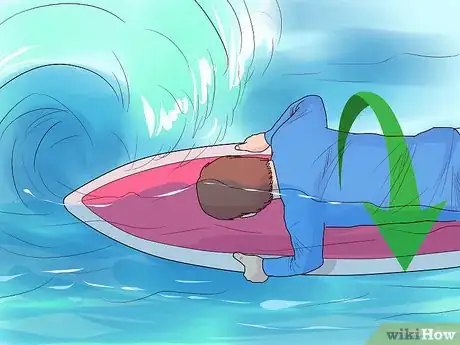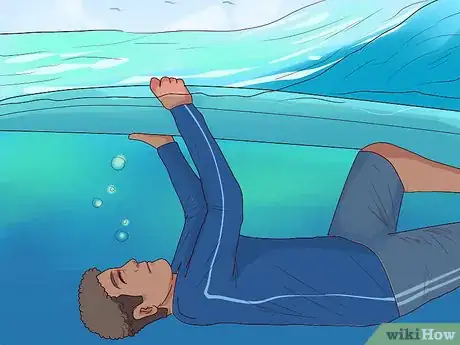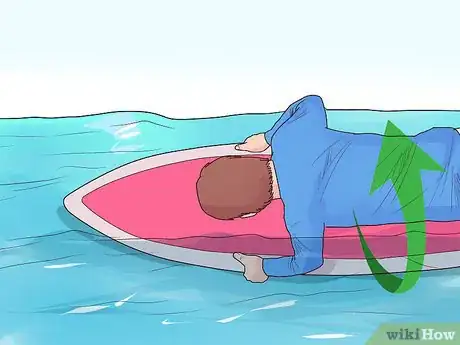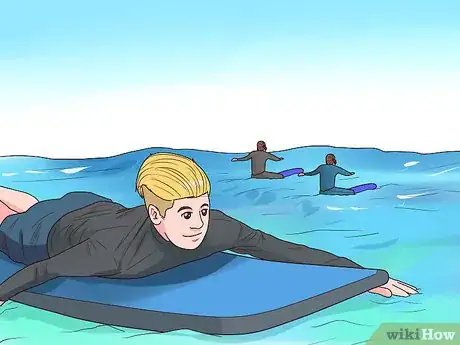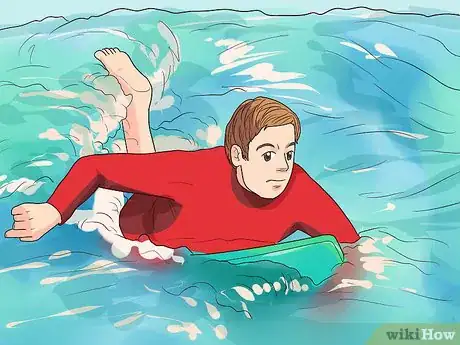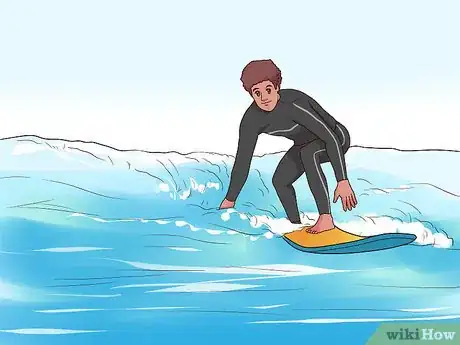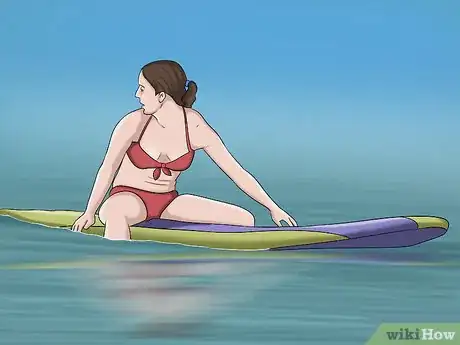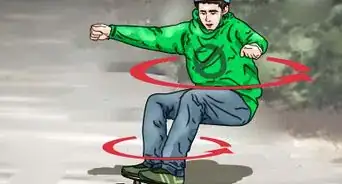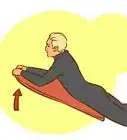This article was co-authored by Jack Herrick, a trusted member of wikiHow's volunteer community. Jack Herrick has a passion for surfing, which has been a love since the early 2000's. He has surfed in Hawaii, Costa Rica, and the Northern California coast.
This article has been viewed 100,715 times.
Learn more...
If you're interested in learning how to surf, a longboard is a great place to start! Longboards are by far one of the easiest boards to learn on because of their stability and ease of catching small to mid-sized waves. Wax your board and check the weather report before heading out to the ocean. Paddle out and use the “turtle roll” technique to let waves pass over you until you catch the perfect one. Paddle hard, stand up quickly, and ride your wave back to shore!
Steps
Getting Ready to Ride a Longboard
-
1Rent or borrow a surfboard 8 foot (2.4 m) or taller. This height is classified as a longboard. These tall boards are great for beginners, since they’re typically more stable and better for catching small waves. Rent your board at a local surf shop or find a friend with an extra board you can borrow.
-
2Wax your longboard to make it less slippery. Apply a basecoat first to make sure the wax sticks, then rub wax overtop in circular and side-to-side motions. Cover the entire top surface of the board, then finish with a topcoat.[1]
- You can also apply wax to the center area of the board’s rails, where you’ll be holding on when you turtle dive. This will help you grip the board more securely.
EXPERT TIPJack Herrick has a passion for surfing, which has been a love since the early 2000's. He has surfed in Hawaii, Costa Rica, and the Northern California coast.Experienced Surfer
 Jack Herrick
Jack Herrick
Experienced SurferYou don't need to wax your surfboard every time you go surfing. Jack Herrick, surfer and founder of wikiHow, tells us: “You only have to wax your surfboard when you feel like the stick is wearing off. So, if you touch it, and it doesn’t feel sticky, then go ahead and wax the spots that have lost their stick.”
Advertisement -
3Check the local surf report for 1–2 foot (0.3–0.6 m) waves for beginners. Use a reliable resource with up-to-date and accurate tide/surf reports, such as https://www.surfline.com. This website covers many regions and also has live web cams that show you current conditions. Check the website before you head out for the day and look for middle level tides, which usually yield good waves.
- Checking the weather report for the day can help keep you from being caught in a storm and experiencing rough surf conditions.
Paddling Out
-
1Walk your board out and start paddling when the water is waist-high. Climb onto your board and lay flat on your stomach, positioning yourself lengthwise along the center. Cup your hands and pump your arms through the water, one at a time, with powerful, decisive crawl-strokes to propel yourself forward.
-
2Adjust your timing and position along the center of the board. Find your “sweet spot,” or the specific position and timing that makes it easiest to paddle by adjusting yourself forward and backward along the center of the board. Usually, the most efficient place to paddle from is when the nose of your board is just out of the water.
- You'll know you've found the sweet spot when you feel how little effort it takes to make you and the board move.
-
3Arch your shoulders and press your abs to the board as you paddle. Good posture raises your leverage and helps conserve energy, letting you propel yourself more powerfully with fewer strokes. Keeping your shoulders back also gives you a better view of what swells are coming your way.
Executing a “Turtle Roll”
-
1Keep your board perpendicular to oncoming waves as you paddle out. These waves are known as “whitewash,” since they’ll appear white as they roll toward you. Keep your paddling consistent and straight, and look up every few seconds to check your positioning. If you accidentally paddle out sideways, the force of the wave can hit the rails and pull the board right out of your arms.[2]
- To correct your positioning, scoot to the back of your board so the nose pops out of the water. Kick your legs in an eggbeater motion, grip the rails with 1 hand, and use the other hand to push yourself around.
- For example, if you want to turn the board to your left, grip the left rail with your left hand and paddle hard with your right hand.
-
2Grab the rails when you see a huge series of waves coming toward you. Stop paddling and grip the sides of board (or the “rails”) solidly with both hands, bending your elbows. Position your hands around the center of the board for the most stability, and push down slightly so the nose of the board isn’t sticking out of the water.[3]
- Never grip the rails at the top, or the “nose” of the board. Positioning your grip there could make the board cartwheel backwards toward shore.
-
3Push your body up with 1 knee and take a deep breath. As the wave approaches, prepare yourself for the moment you’ll flip over. Plant your knee against the board and push up, raising your body and giving yourself extra leverage for when you need to roll.[4]
-
4Roll and flip the board over before the wave reaches you. Timing is essential for a good turtle roll! Moments before the wave passes over you, lean your body to the side and go underwater, gripping the board and bringing it with you. Now you should be laying underwater, facing up, with the board on top of you, fins up.[5]
-
5Hold on tight and wait for the wave to pass over you. Hold your underwater position as the water pushes past, keeping a good grip on the rails. Pull the board down to keep it sealed against the water, while your vertical position beneath it acts as a sea anchor so you don’t get pushed too far back toward shore.[6]
- While underwater, let your legs dangle or keep 1 foot resting against the board as leverage.
- Don’t wrap your legs around the surfboard, since this can make the board cartwheel backwards and doesn’t let your body work as a sea anchor.
-
6Flip back over and climb onto the board once the wave passes. Push the board up and over, flipping it back to its normal face-up position. Keep gripping the sides of the board and let it pull you up with it as it flips over. Kick your legs and push yourself back up onto the board to return to paddling position.[7]
-
7Practice your turtle roll on smaller waves before using it on large swells. Paddle out just far enough to meet some small waves and practice your timing and technique. This will help you get used to the movement of the turtle roll and prepare you for larger waves.
- This move can also be useful for avoiding crashes! If you think someone is about to hit you as you paddle over a wave, quickly flip over into a turtle roll.
Catching a Wave
-
1Position yourself on the outside of the lineup. If you paddle out to a group of surfers waiting for a wave (also known as the “lineup”), try to stay out the way and keep to the edges. Longboards can paddle more quickly and catch smaller waves than normal surfboards, so your outer positioning won’t hurt your chances at catching an amazing wave!
- Be sure not to hog the waves, though. Experienced surfers generally don’t mind surfing with beginners, as long as they’re not being rude or stealing all of the good waves.[8]
- If this is your first time surfing, you may want to pick an area beyond the break where there are fewer surfers. This way, you’ll have less obstacles and people to worry about while you get the hang of your longboard.
-
2Sit on your board as you wait to observe and enjoy the water. This anticipation is one of the best parts of surfing! Feel the water as you lean back on the tail and make wide, sweeping strokes through the water with your cupped hands. Note the rhythm of the waves coming in and out, watching for sets and lulls, and take in the beauty of the ocean. Keep an eye on the horizon for a wave while you wait.
-
3Turn around and paddle hard once you spot a wave. Lay back down on your board and kick your legs in an eggbeater motion while paddling with 1 arm to turn back to face shore. Once you’re facing directly away from the wave, paddle hard with long, deliberate strokes. Keep paddling until you feel a slight lift of a wave at the back of your board, then give a couple more strong paddles.[9]
- While you’re paddling, keep your body toward the back of the board so the nose stays out of the water.
- If you’re a beginner, ask a friend to help push you into a wave or work on your paddling until you can catch a wave.
-
4Stand up quickly to catch the wave and keep your body relaxed. Once you’ve caught the wave, all you have to do is ride it toward shore! Don’t tense up or go rigid—instead, bend your knees and keep your body limber and relaxed. Lean slightly back and forth, adjusting your footing, to get the feel for the stability of the board and the power of the wave.[10]
-
5Keep practicing your technique and don't get discouraged. Get in the water as often as you can. If you practice every day for a week, you’ll be able to see yourself improving! Keep perfecting your paddling, turning, balance, and speed at popping up to standing and you'll be a pro in no time.
- One of the best ways to make surfing low-pressure is to bring a friend and just have fun practicing together!
Warnings
- Don’t use the “duck diving” technique with a longboard. This board is too buoyant for this, and you may end up being tossed backward or being battered by the wave.⧼thumbs_response⧽
- Remember to apply sunscreen before you go surfing so you don't get burned.⧼thumbs_response⧽
- It’s easy to get dehydrated while surfing, especially on hot days, so make sure to drink lots of water.⧼thumbs_response⧽
- Be respectful to other surfers by using proper surf etiquette. Don’t drop in on surfers who are already on the wave, since this limits their mobility and potentially endangers them.⧼thumbs_response⧽
References
- ↑ http://www.surfscience.com/topics/learn-to-surf/surfing-101/how-to-wax-a-surfboard
- ↑ http://www.surfinghandbook.com/knowledge/beginners-surfing-tips/catching-your-first-wave/
- ↑ http://www.surfinghandbook.com/knowledge/beginners-surfing-tips/catching-your-first-wave/
- ↑ https://youtu.be/KLwYjrKhFBs?t=94
- ↑ https://www.surfertoday.com/surfing/how-to-turtle-roll-a-surfboard
- ↑ https://www.surfertoday.com/surfing/how-to-turtle-roll-a-surfboard
- ↑ https://youtu.be/KLwYjrKhFBs?t=147
- ↑ http://www.surfinghandbook.com/knowledge/beginners-surfing-tips/catching-your-first-wave/
- ↑ http://www.surfinghandbook.com/knowledge/beginners-surfing-tips/catching-your-first-wave/
About This Article
To surf on a longboard, start by renting or borrowing a surfboard that’s 8 feet or longer. Next, check the local surf report for 1-2 foot waves for beginners. Then, walk your board out until the water is waist-high, then lay flat on your stomach, cup your hands, and paddle out. Once you're out in the water, sit on your board and watch for a good wave. When you see one, lay back down on your board and paddle hard toward shore, kicking your legs in an eggbeater motion. As you feel the lift of the wave at the back of your board, stand up quickly and ride it to shore. To learn how to practice your longboard technique, keep reading!
